Rhine Valley castles near Bacharach, Germany
The Upper Middle Rhine Valley UNESCO site is the 65-kilometer stretch of the Rhine River in Germany between Bingen and Koblenz. The river is framed by dramatic mountains and punctuated by side valleys. The gentler slopes are covered with vineyards – the region is famous for Reisling. On the hilltops loom castles: about 40 of them! Some are in ruins, some intact, and most date to the Middle Ages.
In the middle of this gorgeous scenery, in one of the side valleys, lies the small walled town of Bacharach, with Stahleck Castle above it in a hill. Bacharach is the perfect base from which to explore the best of the Upper Middle Rhine Valley castles.
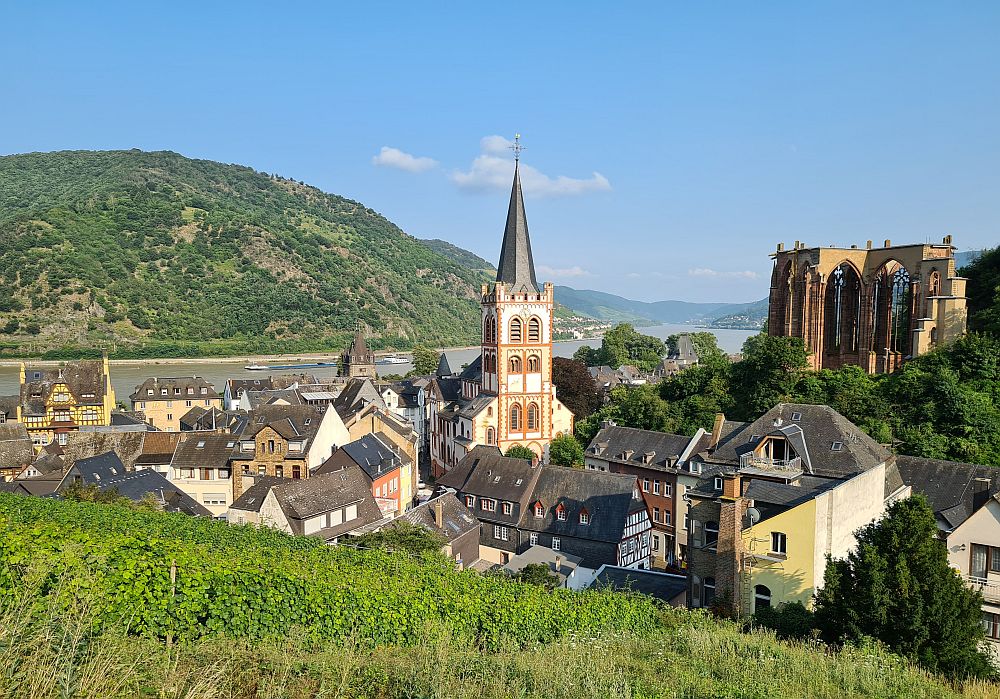
Disclosure: This article contains affiliate links. If you click on one and make a purchase or booking, I will receive a small commission. This will not affect your price.
Bacharach village
But Bacharach is more than just a place to stay while you take in the sights; it’s a picturesque little place squeezed between two steep hills and the river. Within the town you’ll find a range of different architectural styles, and I especially liked the half-timbered houses. They show their age in a particularly charming way. Notice the Rathaus (city hall), for example, and how its timbers curve.
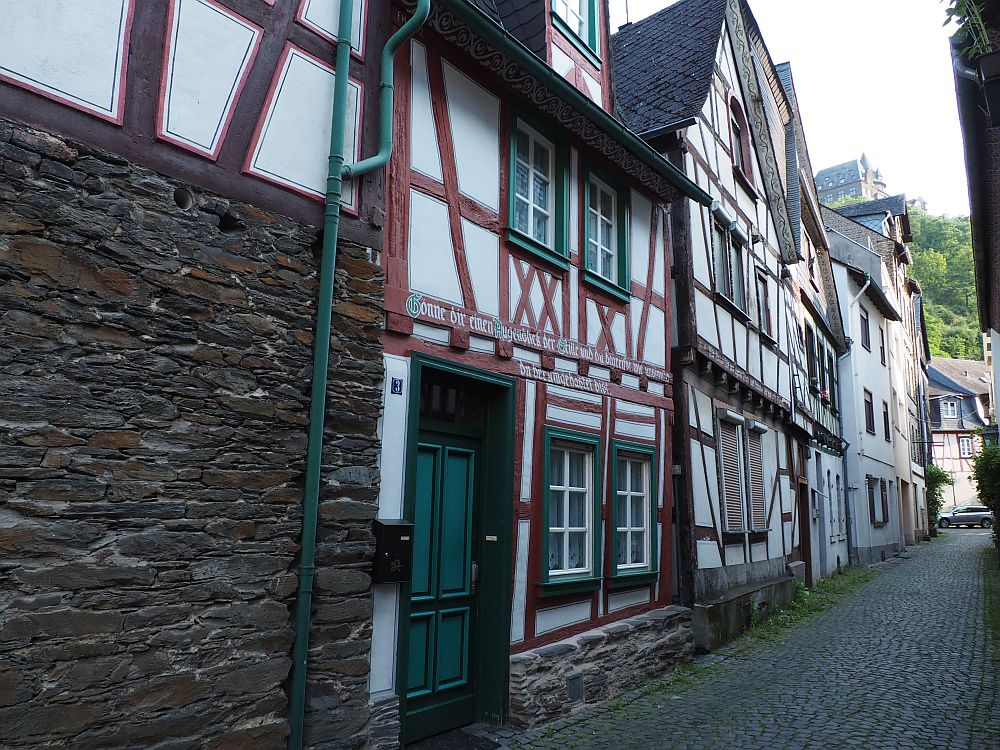
Fortifications
Once entirely fortified, Bacharach still has remnants of its original wall dating to the 14th century, along with several of the wall’s 16 watchtowers, all dating from the 14th century.
Two towers, the Markturm and Münzturm, guard the village as part of the fortification that runs along the river. Each has an archway at its base: one is used today as an entrance to the village and the other as an exit.
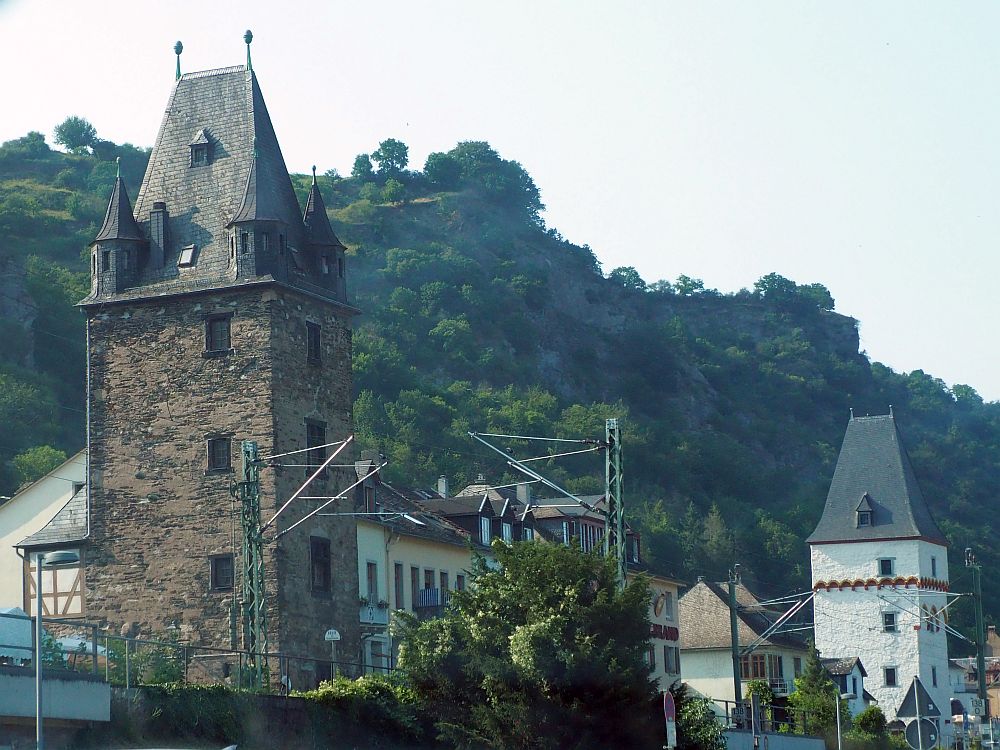
You’ll see another tower on the road going up the steep valley through the town – the road leads right through its gateway. Look uphill from that tower and you’ll see another further up and a bit of wall connecting them. Beyond that, you’ll catch a glimpse of Stahleck Castle, now a youth hostel.
The Sentry Tower, a.k.a. Cat tower, stands above the town (on the right, as you stand with your back to the river) surrounded by vineyards. You can climb it for a breathtaking view over the river, the vineyards, and the town of Bacharach nestling in its valley.
If you’re feeling like a hike, put on some strong shoes and take the path up to Stahleck Castle above the town. It follows the wall past four different towers: Hutturm, Sonnenturm (a ruin), Kühlbergturm and Halbrundturm, and offers wonderful views over the town, the river and the opposite bank. You’ll also get near the ruins of the Werner Chapel.
The riverside wall
Running along the river, or rather along the main route that follows the river, is a large segment of the 14th century wall, with an equally high railway embankment running between it and the road. You can walk or drive through a tunnel under both the rail line and the old wall, but don’t miss walking up the stairs onto the top of the old wall, a public path. Over the centuries, the houses inside the wall have “grown” onto the wall, presumably after it was no longer needed for defense. They have entrances below on the street, but also up on the wall.
Walking along the public path, you’ll pass under a sort of colonnade, where the upper stories of the houses extend outward toward the river. You’ll pass businesses as well, including restaurants. We dined one evening in a little outdoor space between the public path and the rail line. It was a Spanish restaurant called Luz de Mar, and we had paella that was as good as any we’ve had in Spain. The trains – generally very long cargo trains – passed extremely close at very high speed, drowning out any conversation and creating a strong wind as well.
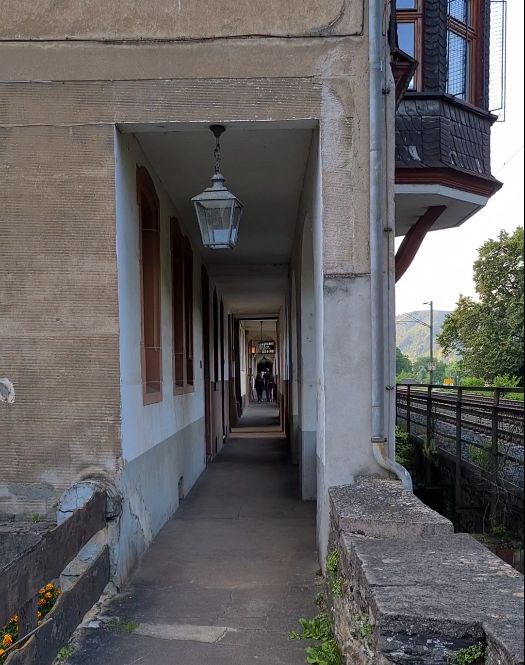
Stahleck Castle
The original Stahleck Castle dates to the Middle Ages but was destroyed in 1689 by the French army under Louis XIV during the Nine Years’ War between France and the Holy Roman Empire (and its allies).
What remained of Stahleck Castle was restored and rebuilt in the 20th century, but for a very different use: as a youth hostel. Little of the castle is original except for the old foundation walls; there are much better and more intact Upper Middle Rhine Valley castles nearby (more on this below). In any case, you can’t get past the courtyard if you’re not staying in the hostel.
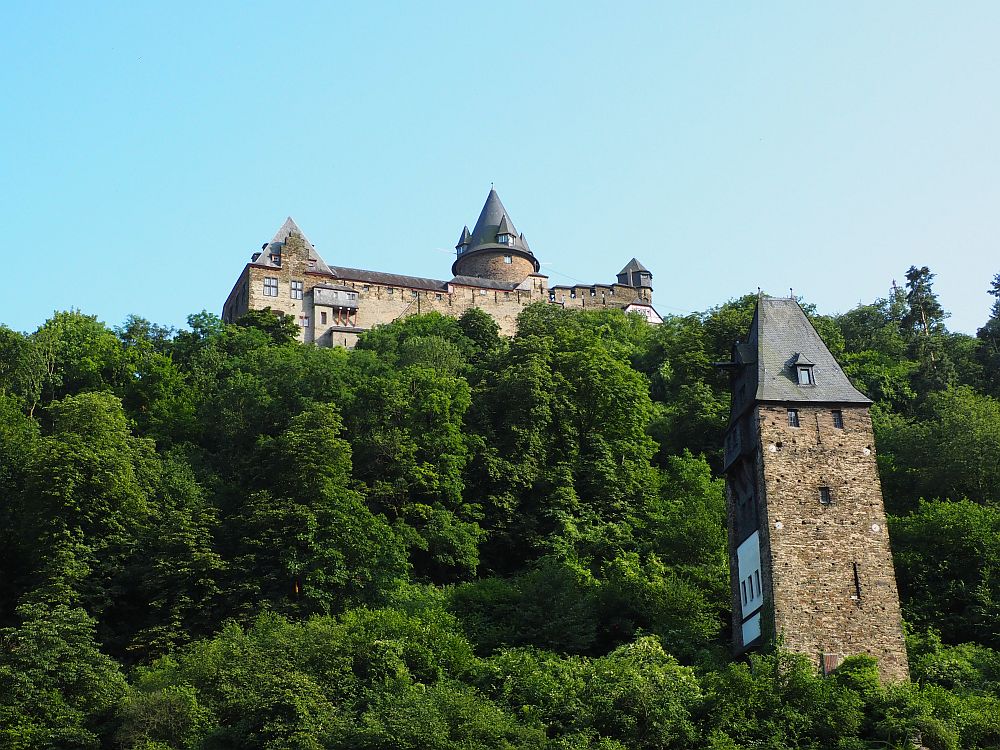
Stahleck Castle (Burg Stahleck): Bacharach. Website.
Churches
Werner Chapel
Werner Chapel is a gothic ruin hinting at how elegant the original church must have been. Begun in the 13th century but not completed until the 15th century, this example of Rhenish High Gothic architecture has a gruesome back story. 1n 1287, a boy named Werner was found dead, stabbed multiple times. The murder was blamed on the local Jews who, it was claimed, had killed the boy as part of a ritual. This led to a pogrom of Jews in Bacharach and other nearby towns, killing over 40 Jews. It’s a typical example of an antisemitic “blood libel” that has resurfaced time and again for centuries.
Anyway, Bacharach residents started building the chapel in Werner’s honor. They also attempted unsuccessfully to get Werner canonized, both in the immediate aftermath of his murder and a hundred years later. Nevertheless, the location became a place of pilgrimage. In the 17th century, the church was partially destroyed in the same attack that destroyed the castle nearby.
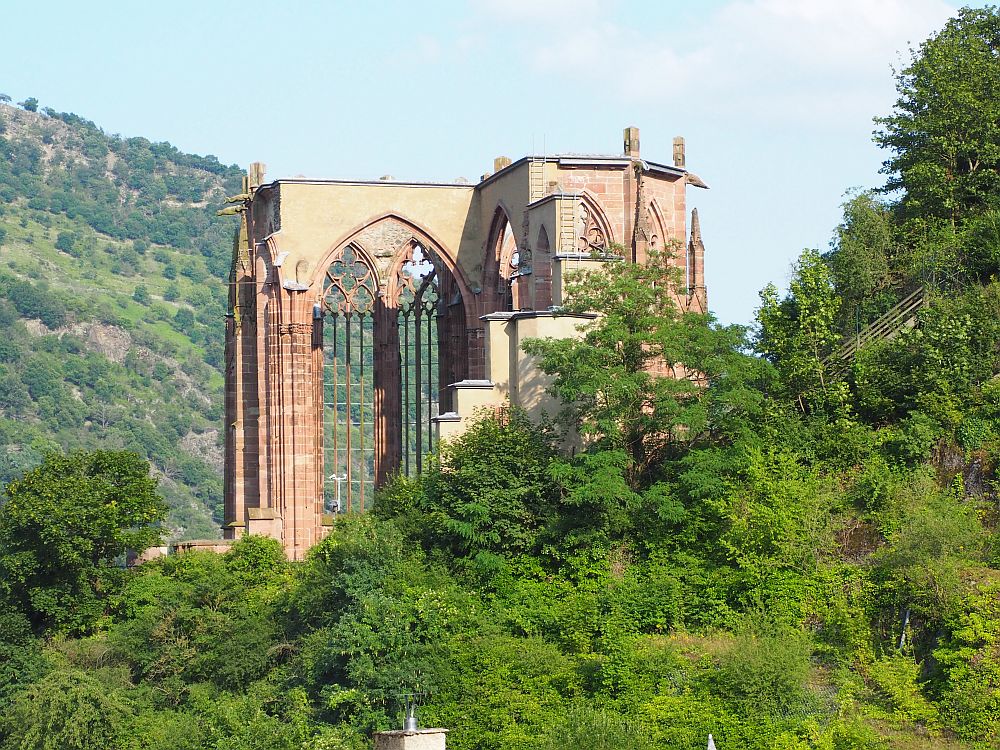
The Church of St. Peter
This church in the center of Bacharach, today a Protestant church, dates to the 13th century and is in a late Romanesque style, with some later Gothic additions. Take a look inside, if it’s open, at its pretty, light-filled interior.
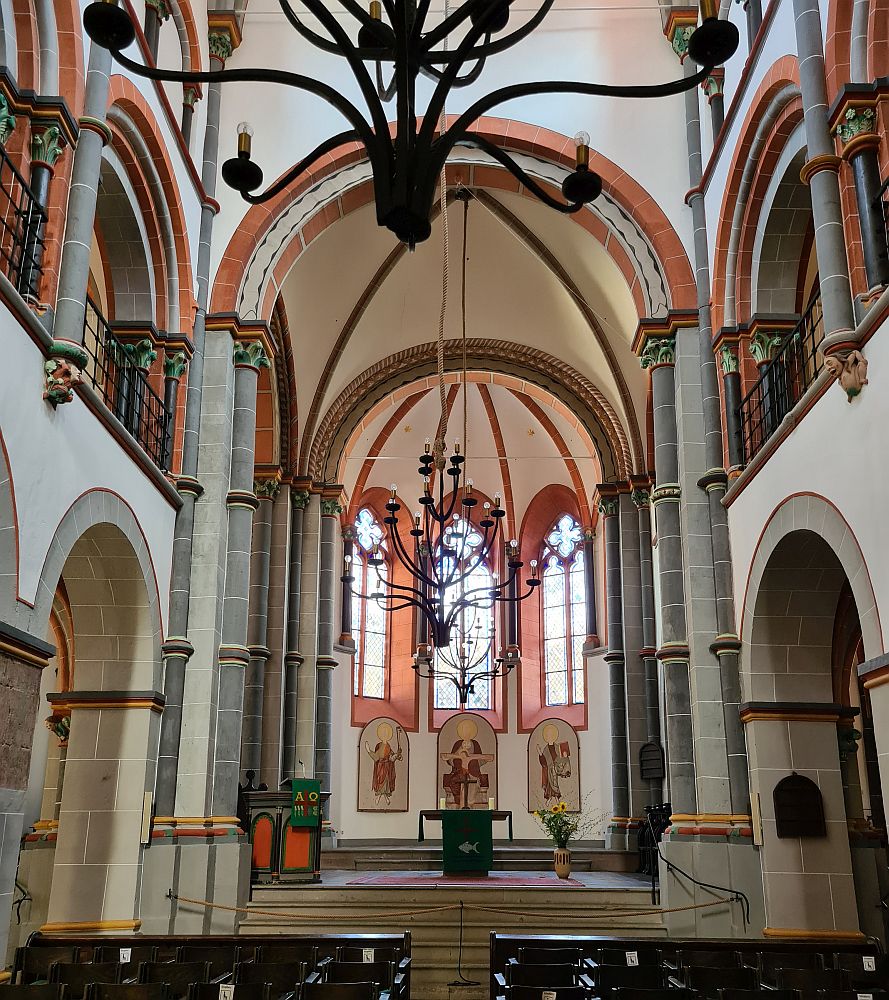
Rhine Valley castles north of Bacharach
The following castles are all between Bacharach and Koblenz. I’ve listed them in order, assuming that you’ll first cross the river from Engelsburg to Kaub, then drive north up the right bank. Just under Koblenz you’ll cross the route 327 bridge and drive south down the left bank until you reach Bacharach again.
On the map below I’ve marked all of the places mentioned in this article.
1. Pfalzgrafenstein Castle
This is a very unusual castle, and I’ve seen lots of castles. It sits on a tiny island in the middle of the Rhine, and functioned primarily as a toll station, forcing ships to stop and pay for the privilege of passing along the Rhine. This use of the castle went on for centuries, starting when it was built in the 14th century and not ending until 1867. On the left bank of the river you can see it from a distance, but you can visit it from the town of Kaub on the other side.
So your first step is to take the ferry across to Kaub, then take the ferry to the island.
Nowadays Pfalzgrafenstein Castle is a museum. We happened to visit this area just when a huge flood was happening, and, as you can see in the photo, the water was exceedingly high, so the castle was closed. Normally you can see a bit of the land it sits on, where there’s a small clump of trees. Nevertheless, we got a good look on the ferry ride across the river.
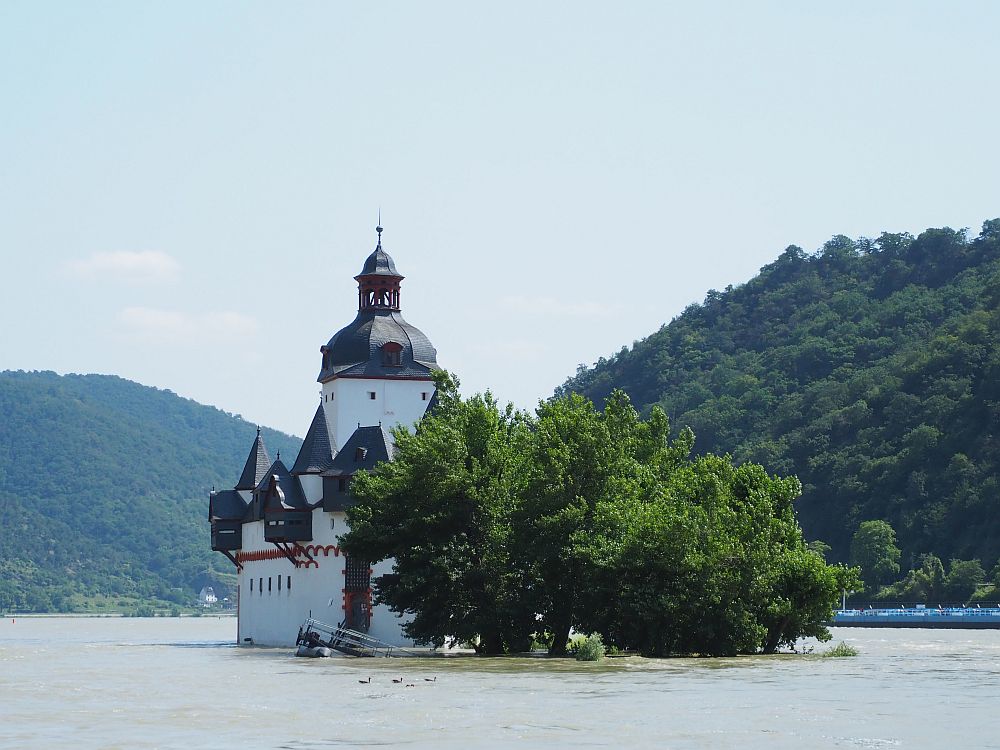
Pfalzgrafenstein Castle (Burg Pfalzgrafenstein): mid-Rhine between Engelsburg and Kaub. Reachable by ferry from Kaub.
After visiting Pfalzgrafenstein, head north on route 42, up the right bank of the river.
2. Gutenfels Castle
Gutenfels Castle perches picturesquely on a hill above Kaub, looking every inch the quintessential medieval castle. That’s exactly what it is, dating from 1220. It helped enforce the toll collecting carried out by Pfalzgrafenstein Castle. Today it is a privately-owned hotel.
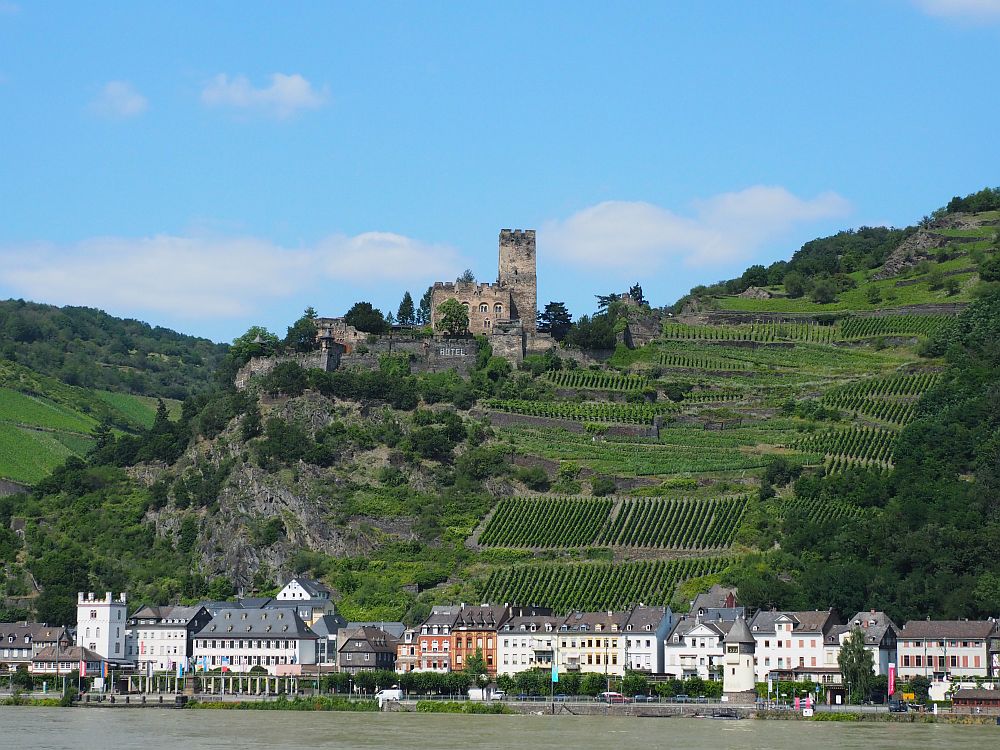
Loreley
This isn’t a castle, but on your way north along the river to Katz Castle, you’ll pass the famous Loreley. This is a dramatic rock cliff that the river curves around. There’s a visitors center and a landscaped park up the hill that has some beautiful views over the river.
3. Katz Castle
Katz (Cat) Castle is a 19th-century rebuild of a ruined 14th-century castle, originally built by the Counts of Katzenelnbogen. It eventually became known as Katz Castle (Cat Castle) for short. Poised above St. Goarshausen, Katz Castle is private property now, so you can only admire it from afar.
4. Maus Castle
Continuing your drive up Route 42, you’ll come to Maus Castle, the Archbishop of Trier’s response to the building of Katz Castle. Originally called Peterseck, it gained the nicknamed Maus (Mouse) Castle as a counterpart to Katz. While much of its medieval look has been preserved, it was also remodeled in the Romantic style of the 19th century, and is now in private hands.
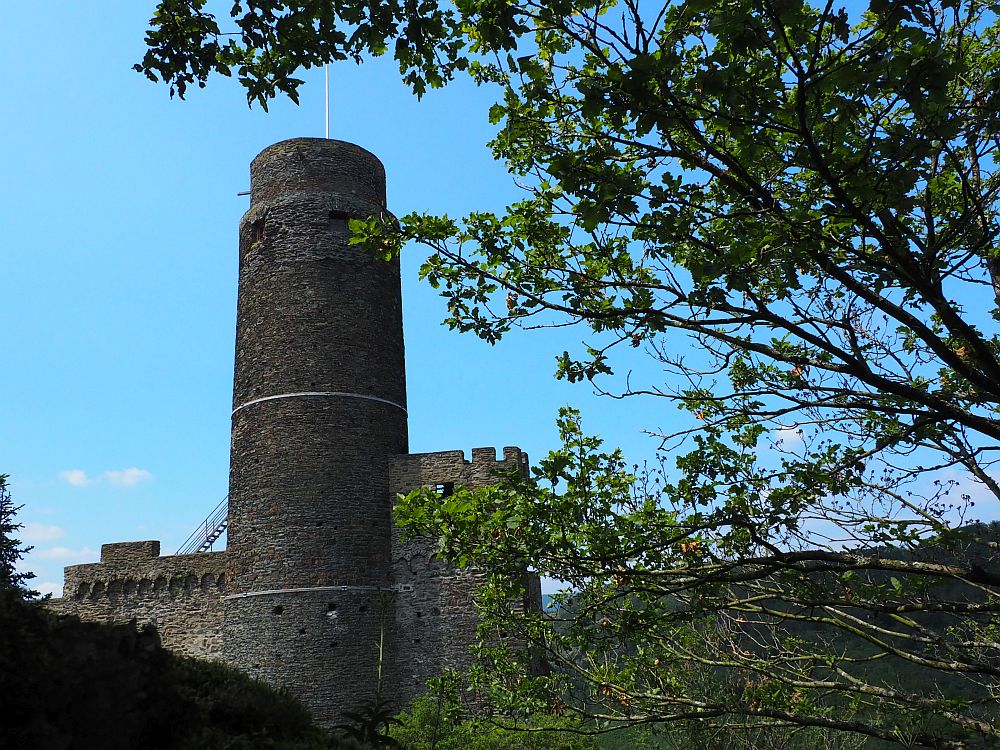
You can see Maus Castle quite well from the opposite side of the Rhine or from the river below. If you feel like a walk, climb up to it and around it to view it from the other side, as in the photo above.
Maus Castle (Burg Maus): above Wellmich. Website (in German; use Google translate).
5. Liebenstein Castle and 6. Sterrenberg Castle
Continuing up the right bank of the river, you’ll next spot Liebenstein and Sterrenberg on a hill to your right. Both date to the 13th century and supposedly were the result of a feud between two brothers. They stand close enough to look like the ruins of a single castle extending along the hill, though there’s a big wall between the two. While Sterrenberg is a ruin – used for events from time to time – the original main tower of Liebenstein is now home to a hotel. Its rooms very much play on the medieval theme.
Hotel Burg Liebenstein: Kamp-Bornhofen. Website.
7. Marksburg Castle
Marksburg sits proudly atop a hill, visible for miles around. It has never been destroyed, so its appearance is much more authentic than many of them.
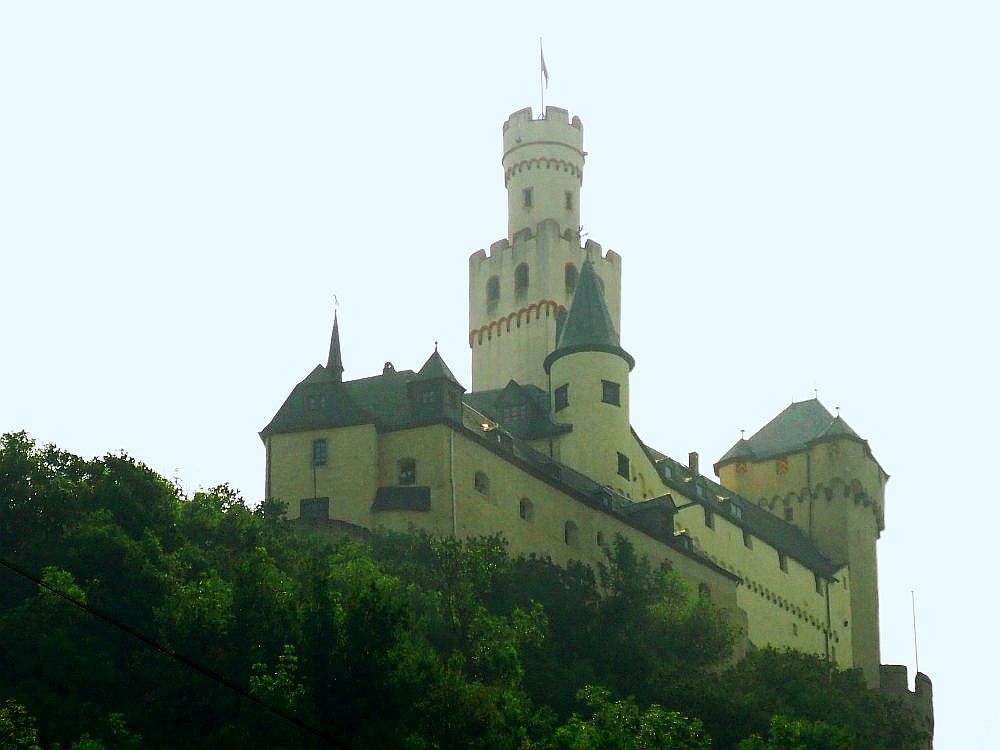
It dates in part to the 13th century, though parts were added in the 14th and 15th as well. Its interiors have been returned to their medieval appearance through restoration and through the furnishings. They’re not original but they illustrate what life might have been like in this type of fortress castle in the Middle Ages. The medieval atmosphere starts right at the entrance: cut straight through rock, it would have been relatively easy to defend. There’s also an interesting armor collection – some replicas, some original – showing armor as far back as the ancient Greeks.
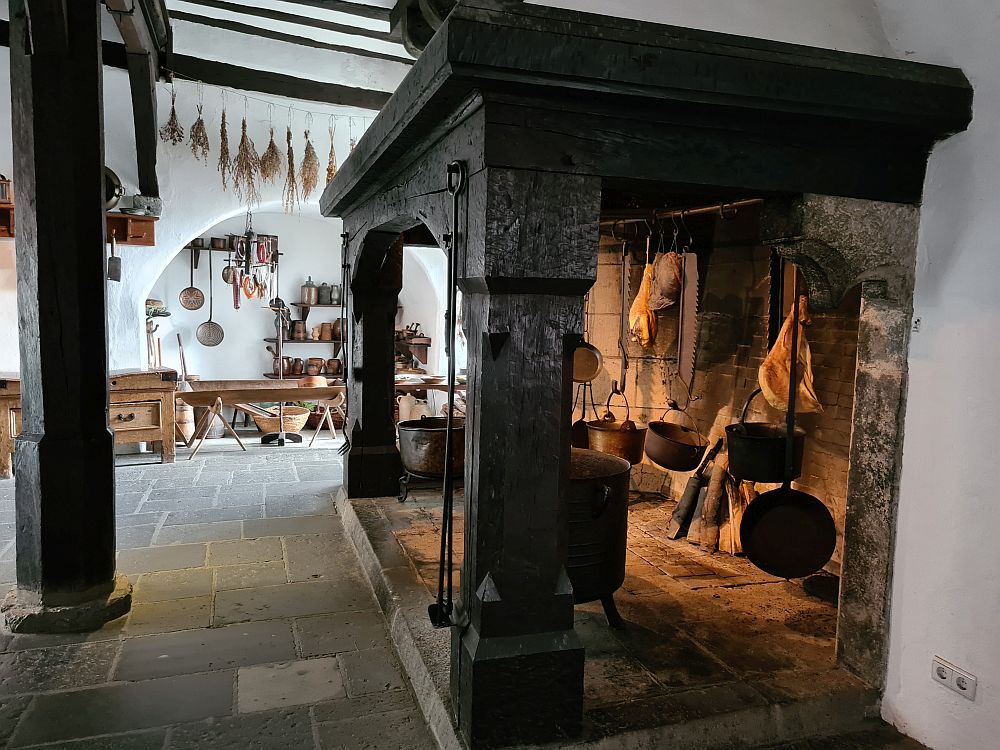
You can only visit as part of a guided tour that takes about an hour. One is offered in English at 13:00 during the summer months. Otherwise, you can take the German tours but with a downloaded text version of the tour.
Marksburg Castle (Die Marksburg): Braubach. Website.
8. Philippsburg Castle
Philippsburg, named after Philipp II of Hesse-Rheinfels, is less of a castle and has more of a manor house look today, sitting below the much more impressive Marksburg Castle. Phillippsburg was intended as a residence for Philipp’s widow, Anna Elisabeth, and was built in the 16th century. Over the centuries parts have been removed of what once was more castle-like, protected by the town of Braubach’s original fortifications. It now houses the offices of the European Castle Institute. A trail leads between Philippsburg and Marksburg, complete with signposts (in German) explaining aspects of castles and castle life.
Philippsburg Castle (Schloss Philippsburg): Braubach. Website.
9. Martinsburg Castle
This 15th-century castle in Lahnstein, originally a toll castle, isn’t as impressive as many of the others. Perhaps that’s because it doesn’t stand on a hill, so it doesn’t have that atmosphere of power that many of the others do. Nevertheless, it is one of few that were never destroyed, though it has been added to over the centuries. The tall hexagonal keep is the most striking part of it. Parts of the castle are private but it is also home to a carnival museum. If you don’t mind a 45-step stairway, you can rent the gatekeeper’s room as your accommodation.
10. Lahneck Castle
Lahneck Castle, above the town of Lahnstein, dates to the 13th century, built on this site by the Archbishop of Mainz to guard the mouth of the river Lahn. It boasts a number of important connections:
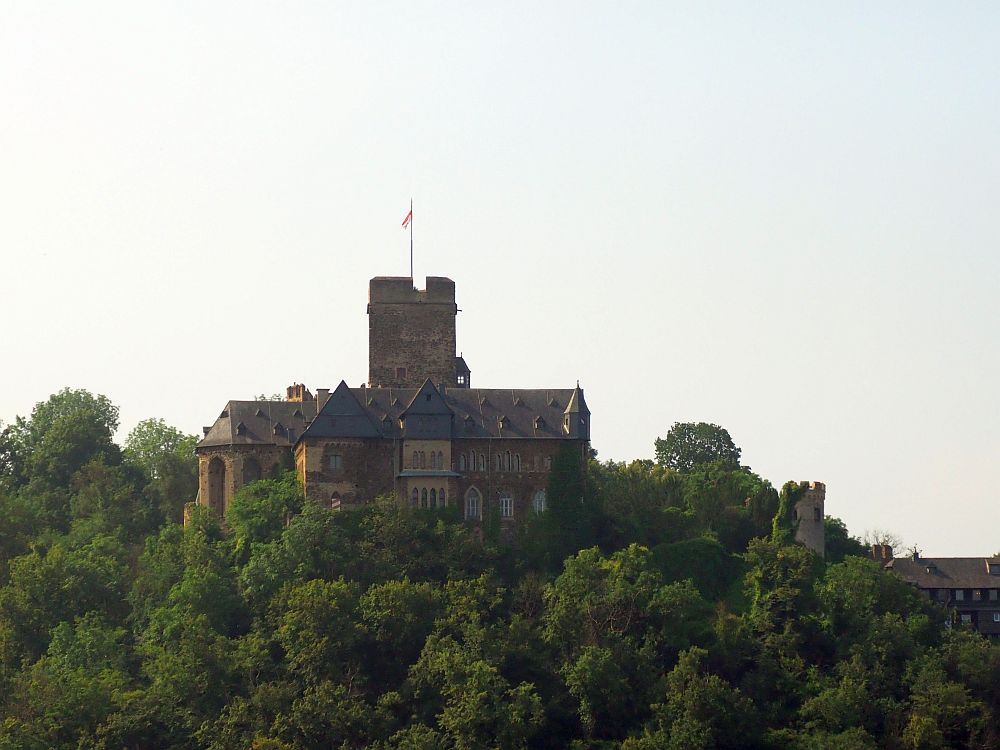
- The last of the Knights Templar, the story goes, took refuge here in 1312 after the Pope ordered them to disband. They resisted the army of the Archbishop of Mainz and all but one died in battle. The last remaining Templar, ordered to surrender, instead grabbed the leader of the Archbishop’s forces and took him with him to fall into the castle’s moat.
- In 1774 Goethe wrote his poem “Geistesgruß” after seeing Lahneck Castle.
- In 1851, an English teenager named Idilia Dubb came to the area with her family on vacation. She went off to do some drawing and never came back. A police search failed to find any trace of her. It turned out she had climbed the ruined tower at Lahneck and the stairway had collapsed after her. Unable to escape, she died there. Her body wasn’t found until 1862 when the castle was being renovated.
Today, Lahneck Castle offers guided tours as well as a restaurant and campground.
Lahneck Castle (Burg Lahneck): Lahnstein. Website.
From Route 42, turn onto route 327 to cross the bridge, then exit to route 9 south, which takes you down the left bank of the river.
11. Stolzenfels Castle
This is another example of the 19th century Romantic Gothic Revival aesthetic, and in this case, quite a grand example. The original 13th-century castle, ruined, like Stahleck, in the Nine Years’ War, came into the hands of the future King of Prussia in 1823. He turned it into a palace to serve as his summer residence. We did not visit it, but it is open to the public and seems to have interiors to match that Romantic aesthetic.
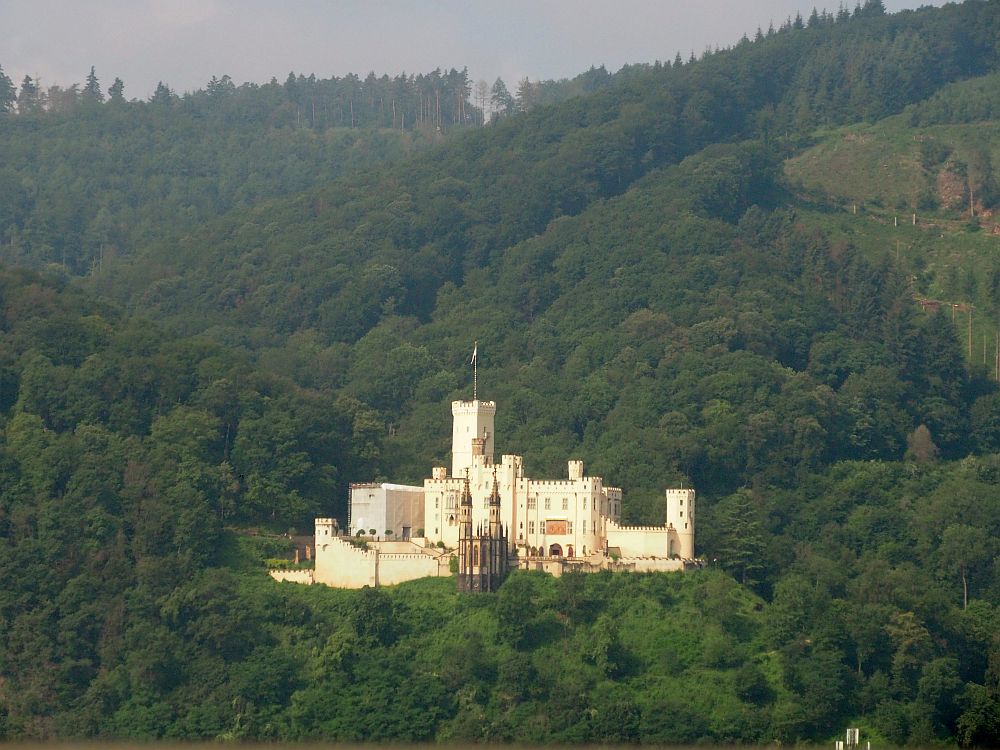
Stolzenfels Castle (Schloss Stolzenfels): the address is in Koblenz but it is south of the city, directly opposite the town of Lahnstein. Website (in German; use Google translate).
12. Rheinfels Castle
Now a ruin, Rheinfels Castle dates to the 13th century and was once the largest castle and fortress along the Rhine, sprawling along a ridge above the river. One part of it has been restored to serve as a hotel, but the rest is open for visitors. There’s also a small museum in what was once the chapel.
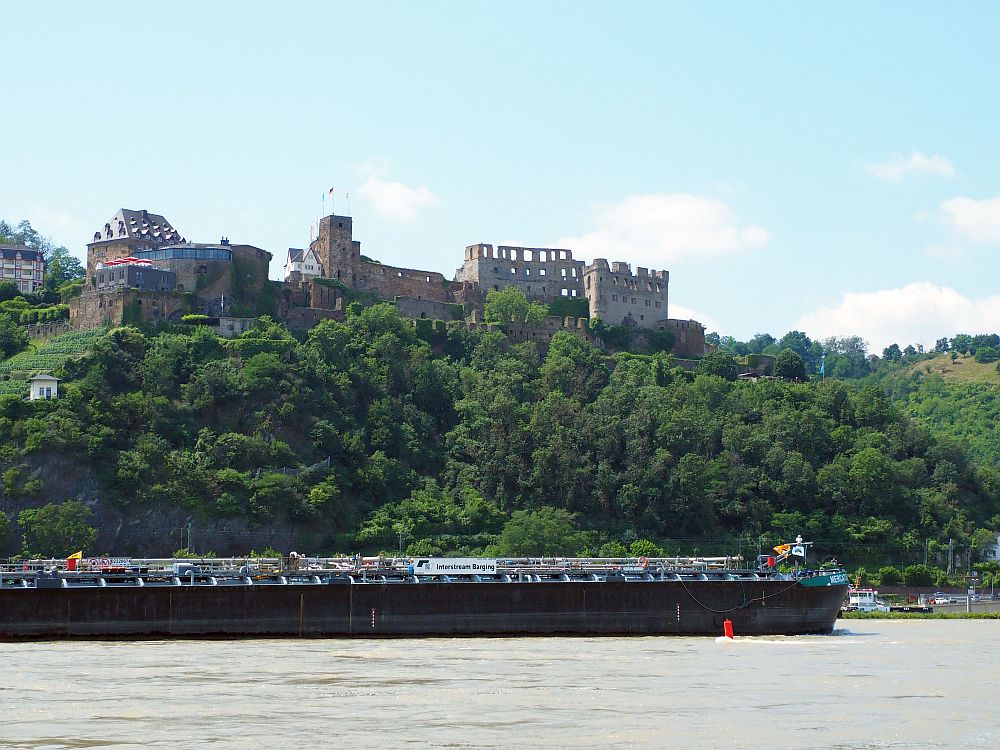
Rheinfels Castle (Burg Rheinfels): Sankt Goar. Website (in German; use Google translate).
13. Schönburg Castle
This is one of the oldest castles on the Rhine, possibly dating to the 10th century, and belonged to the powerful Dukes of Schönburg. Like Stahleck and Stolzenfels, the French destroyed it in 1689 and it remained an extensive ruin for another 200 years. In the early 20th century, an American named Rhinelander (As you might guess from the name, he had German ancestry.) bought the castle and restored it. His son sold it to the town of Oberwesel in 1950, and it now operates as a hotel and restaurant.
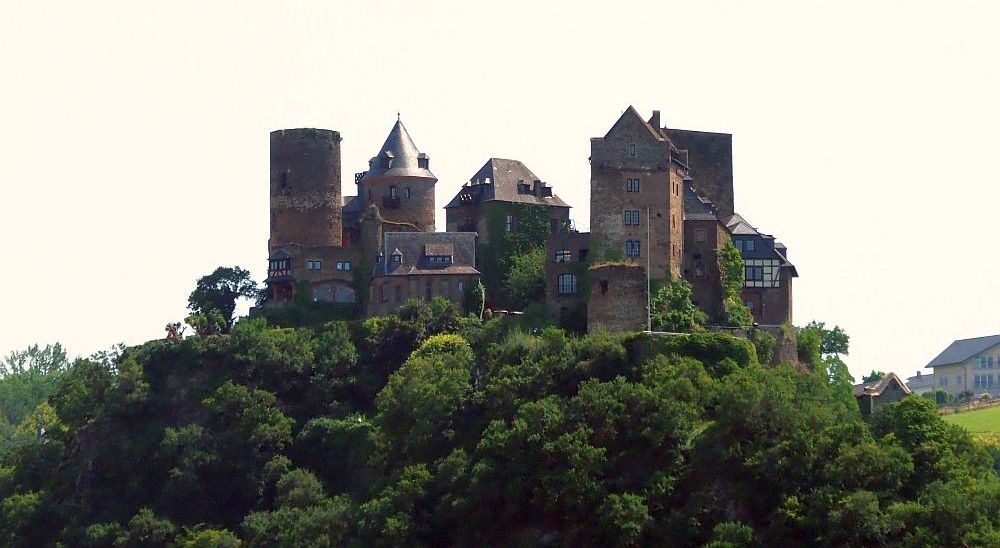
There’s also a small museum inside one of Schönburg’s towers, with access to the roof to take in the view.
Schönburg Castle (Burghotel auf Schönburg). Oberwesel. Website.
On your way back to Bacharach, you’ll pass Pfalzgrafenstein again, which you’ll see on its island in the Rhine to your left.
Rhine Valley castles south of Bacharach
The rest of the castles in this list are on the left bank below Bacharach, so there’s no need to cross the river again. However, often the views are wonderful from across the way. Take the Engelburg to Kaub ferry or the Niederheimbach to Lorch ferry across, if that interests you.
1. Sooneck Castle
Sooneck Castle is another very picturesque one, complete with crenellated walls and tower. While the original was built in the 13th century, it was destroyed by King Rudolf I soon after and not rebuilt until the 14th century. Like Stahleck, Stolzenfels, and Schönburg, Louis XIV’s army destroyed it in 1689. Unlike some of the other castles, which were rebuilt to fit a 19th-century view of what a medieval castle ought to look like, this one became a hunting lodge. The redesign mostly stuck to the original design, though with some additions in the Romantic neo-gothic style. The interior is also Romantic style.
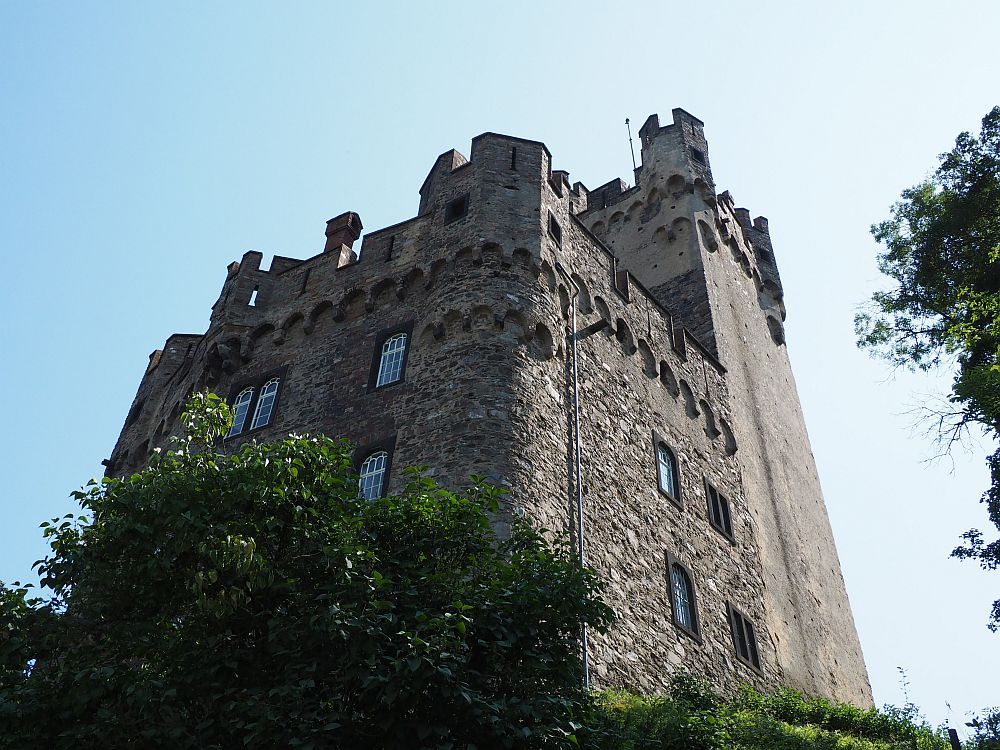
Sooneck Castle (Burg Sooneck): Niederheimbach. Website (in German; use Google translate).
2. Reichenstein Castle
Reichenstein Castle sprawls along a slope above vineyards – and a large campground. This is another originally medieval castle (11th century) that was renovated in the 19th century to conform to the then-current Romantic style. The earlier castle was destroyed, like the others mentioned above, by the French army in 1689.
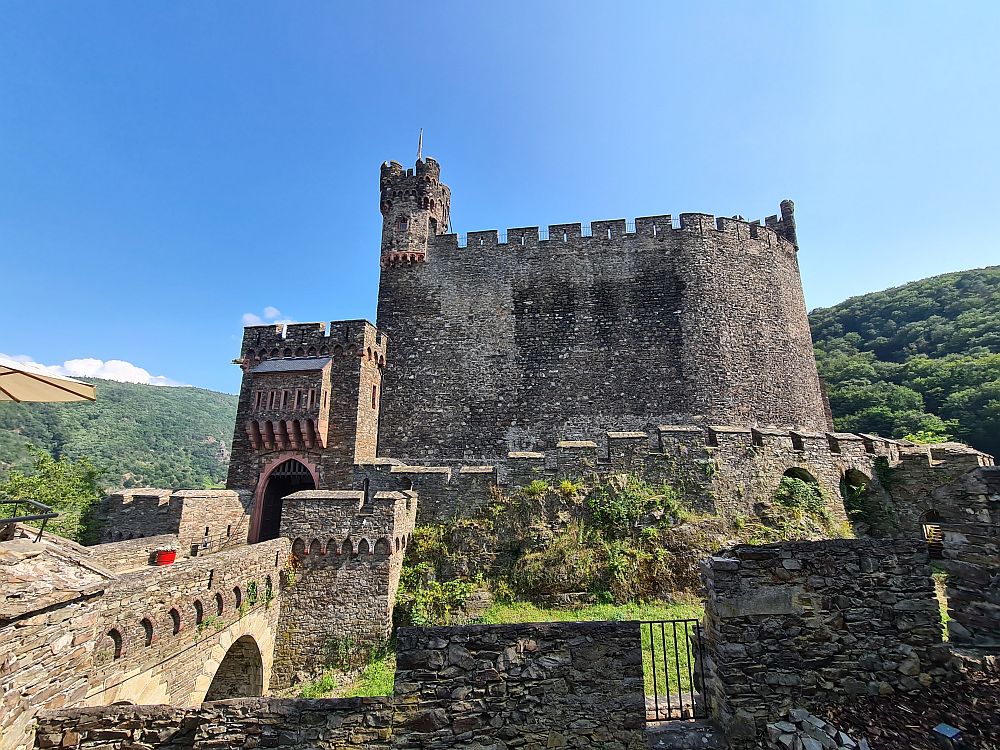
Inside the rebuild, like at Sooneck, Reichenstein’s museum rooms – it also houses a hotel and a restaurant – are in that 19th-century style as well. This gives a wonderfully clear idea of the look that was popular at the time: as Reichenstein’s website puts it “the spirit of Rhine Romanticism.”
The furniture is ornate, heavy and laden with images of coats of arms. The rooms teem with objects meant to emphasize that medieval look: things like full suits of armor and other weapons and 1200 hunting trophies.
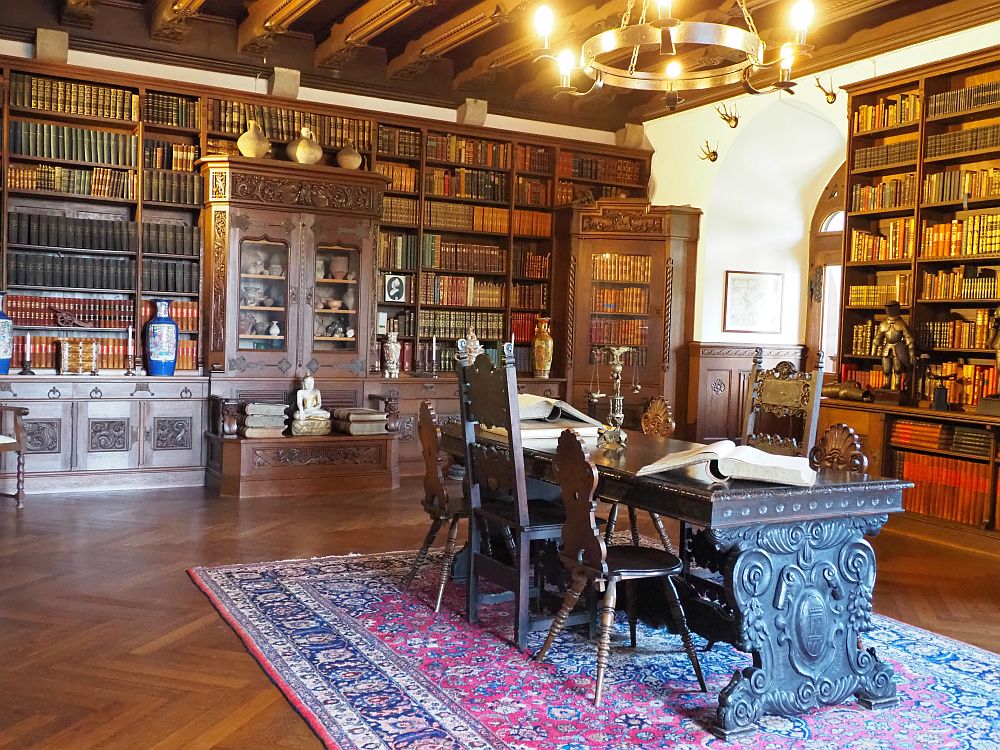
Reichenstein Castle (Burg Reichenstein) in Trechtingshausen. Website.
3. Rheinstein Castle
Rheinstein Castle’s history resembles the others above that stem from the Middle Ages – in this case late 13th or early 14th century – but were restored in the 19th century to match the current thinking about the Middle Ages. In this case, the castle had a different name, Fautsburg, and changed hands many times over the centuries, which didn’t help its preservation.
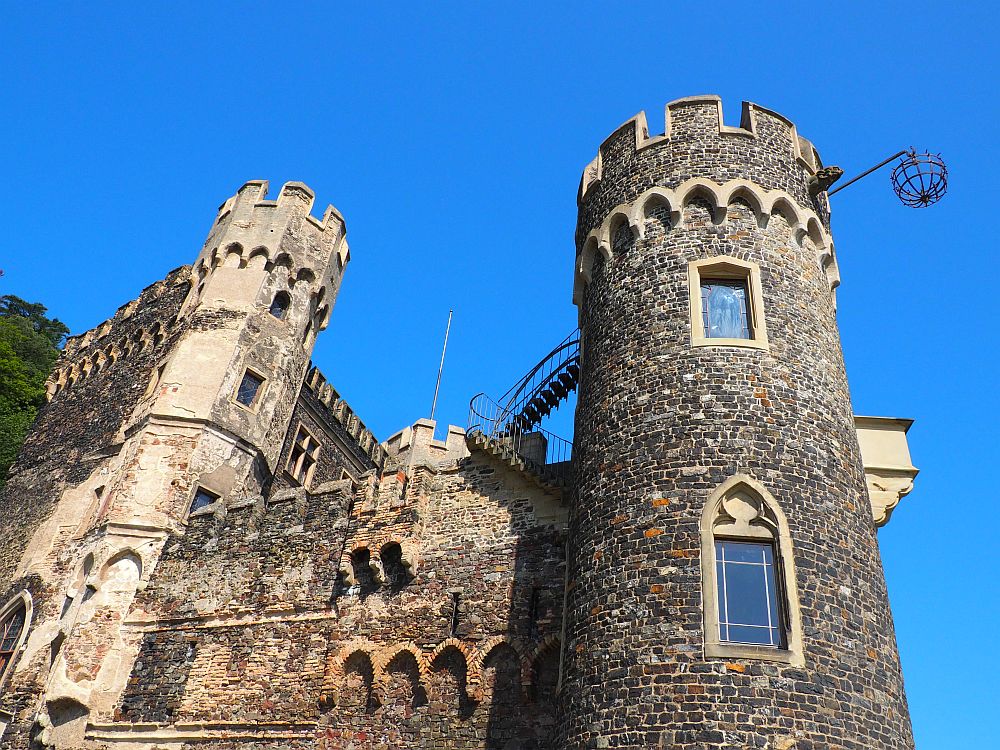
In the 19th century, the castle came into the hands of Prussian princes, who renamed it Rheinstein and financed the renovation. The tomb under the chapel here – which, by the way, is a mid-18th-century structure, despite its high gothic appearance – holds two Prussian princes and a princess.
Descendants of the Prussian nobility lived in the castle until the 1970s. An opera singer named Hermann Hecher bought the castle in 1975 in order to avoid its sale to the Hare Krishna sect. His descendants own and operate the castle today as a museum and restaurant.
The castle’s museum rooms do a good job both in showing the 19th-century furnishings and also pointing out how the different parts of the castle were used in the Middle Ages. The views over the river and the vineyards on the opposite bank are stunning. So is the little garden next to the castle.
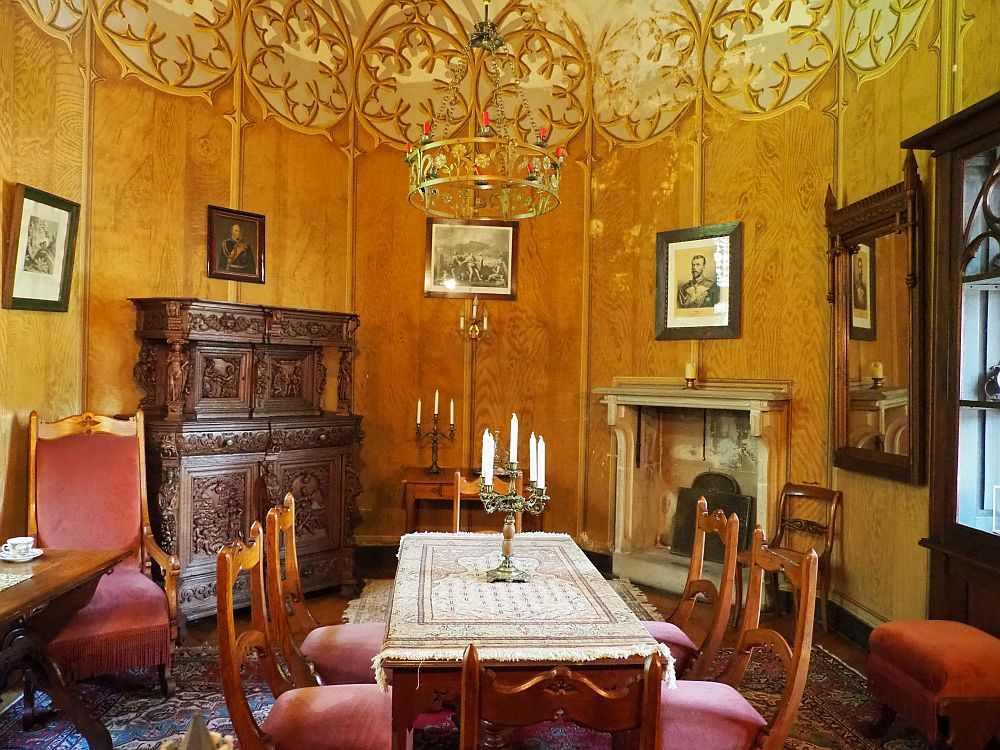
Rheinstein Castle (Burg Rheinstein) in Trechtingshausen. Website (in German. Use Google translate).
Which are the best Rhine Valley castles to visit?
If you can only see a few of the castles in the Rhine Valley, at least see Pfalzgrafenstein because it’s so unusual and picturesque, Marksburg for a look at life in the Middle Ages, and either Reichenstein or Rheinstein for the 19th-century version. Stolzenfels might be worth visiting too, but since we didn’t get to visit it, I can’t say for sure.
Even if you only see a couple castles up close, you’ll see plenty just by driving – or taking a riverboat or train – along this stretch of the Rhine. It’s an enchanting moment when you spot a castle atop a hill and wonder at its beauty and history.
This article hasn’t listed all 40 Rhine Valley castles, as you can see, but I’ve included all of the significant ones within the UNESCO-designated Upper Middle Rhine Valley site. I also listed lesser ones that I saw from a distance, even if I couldn’t or didn’t visit them. You could visit two or three a day, or more if you don’t see the insides. This is assuming you have a car to travel between them. Plan more days, though, if you’d like to hike in the hills to see the magnificent views over hills and castles.
If you’d like to read about more of these 19th-century Romanticist castle renovations, try these articles:
Where can you cross the Rhine river?
If you’re traveling by car, you can cross the river just south of Koblenz at the north end of the UNESCO-designated area. At the south end of this stretch of the river, you’d have to go all the way down to Mainz to cross the river, right under the spa town of Wiesbaden.
However, there are plenty of places to cross by ferryboat, taking your car with you. In order from north to south, here are the crossing points:
- Bad Salzig – Kamp-Bornhofen, which is right under Liebenstein and Sterrenberg castles.
- St. Goar – Goarshausen
- Engelsburg-Kaub. This is the one with the great view of Pfalzgrafenstein.
- Niederheimbach-Lorch
- Bingen- Rüdesheimer
For any of them, just drive to the launch point and wait. It shouldn’t be long.
Where to stay
Bacharach
We stayed at Hotel Restaurant Altkölnischer Hof, which was clean and comfortable and right in the center of Bacharach. On the map below, you can find hotels in Bacharach, or zoom out to find hotels along the river nearby.
A castle
If you want to immerse yourself in the castle experience, think about staying in a castle. Of the ones listed here, the following all offer lodgings:
- Stahleck Castle in Bacharach: a youth hostel
- Gutenfels Castle in Kaub
- Liebenstein Castle in Kamp-Bornhofen
- Martinsburg Castle in Lahnstein: the gatekeeper’s room
- Rheinfels Castle in St. Goar
- Schönburg Castle in Oberwesel
- Reichenstein Castle in Trechtingshausen
Other options
Walking
Take an 8-day walking tour between Rudesheim and Koblenz. It’s self-guided but accommodations and breakfasts are arranged for you, and you don’t have to carry your luggage!
River cruises
There are many companies that do cruises along the Rhine, with or without stops to tour castles. Boat Bike Tours has its Cologne-Mainz route that involves bicycling along the valley. Lots of companies offer more traditional river cruising: Viking, Ama Waterways, Tauck, and Emerald Cruises, to name a few, offer week-long or longer cruises that include this segment of the Rhine and offer sightseeing excursions.
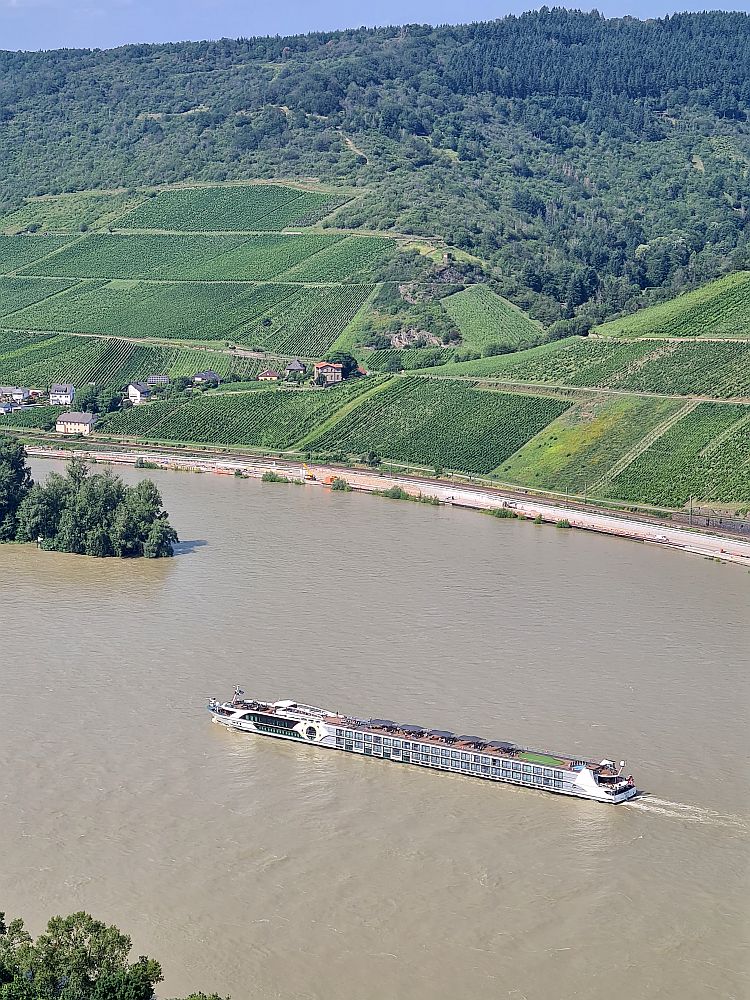
If you’re driving, you could get a quick taste of river cruises in a day on this short boat ride from Frankfurt, which includes wine-tasting.
Train
Another way to see the Upper Middle Rhine Valley castles is to take the West Rhine Valley Line Scenic train between Mainz and Koblenz, which runs along the west bank of the river between Bingen and Koblenz. This used to be the only train line, but now a more direct high-speed line away from the river connects Mainz and Koblenz. When you buy your ticket, make sure to specify that you want the scenic one. Some of the scenic trains are express, skipping the smaller stations, but if you take a regional you can get off at any of the left bank towns. As you pass Bacharach, watch for the impossibly nearby houses, and the people dining on paella right next to the track!
Use the German rail system website to look up the schedule and book. When you fill in the dates and towns, make sure to add a stopover of 0 minutes in, say, Bacharach. That will ensure you get the Rhine Valley train and not the high-speed one. Another way to make sure is to click on “show details” to see that the train makes intermediate stops at the towns along the Rhine. The more stops, the longer the trip, which in this case might be a good thing! By the way, Hbf means “main train station.”
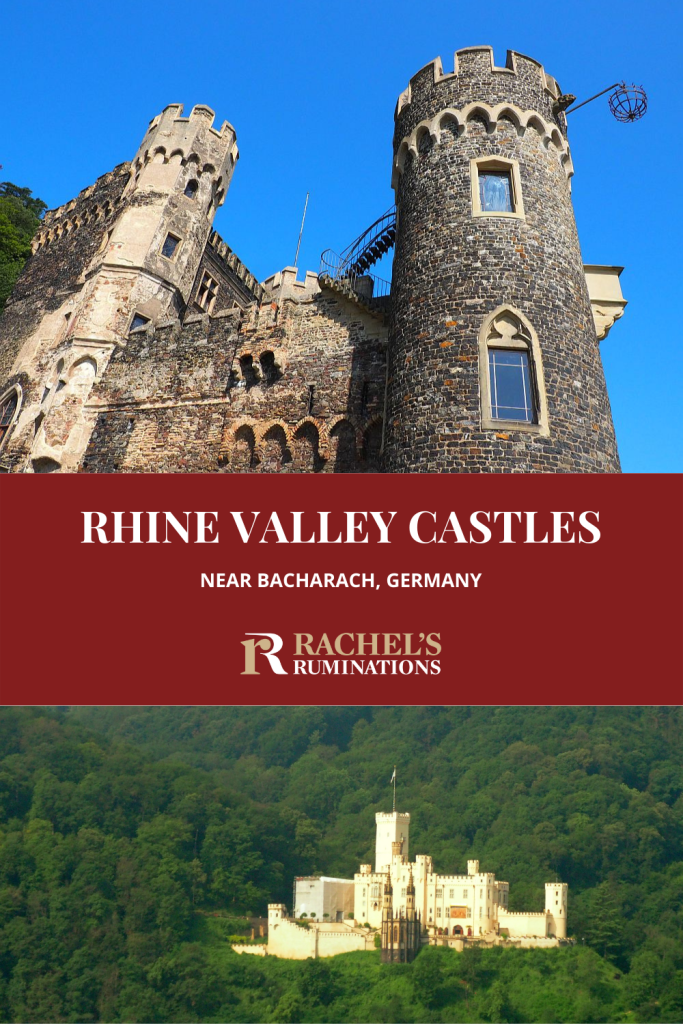
My travel recommendations
Planning travel
- Skyscanner is where I always start my flight searches.
- Booking.com is the company I use most for finding accommodations. If you prefer, Expedia offers more or less the same.
- Discover Cars offers an easy way to compare prices from all of the major car-rental companies in one place.
- Use Viator or GetYourGuide to find walking tours, day tours, airport pickups, city cards, tickets and whatever else you need at your destination.
- Bookmundi is great when you’re looking for a longer tour of a few days to a few weeks, private or with a group, pretty much anywhere in the world. Lots of different tour companies list their tours here, so you can comparison shop.
- GetTransfer is the place to book your airport-to-hotel transfers (and vice-versa). It’s so reassuring to have this all set up and paid for ahead of time, rather than having to make decisions after a long, tiring flight!
- Buy a GoCity Pass when you’re planning to do a lot of sightseeing on a city trip. It can save you a lot on admissions to museums and other attractions in big cities like New York and Amsterdam.
- Ferryhopper is a convenient way to book ferries ahead of time. They cover ferry bookings in 33 different countries at last count.
Other travel-related items
- It’s really awkward to have to rely on WIFI when you travel overseas. I’ve tried several e-sim cards, and GigSky’s e-sim was the one that was easiest to activate and use. You buy it through their app and activate it when you need it. Use the code RACHEL10 to get a 10% discount!
- Another option I just recently tried for the first time is a portable wifi modem by WifiCandy. It supports up to 8 devices and you just carry it along in your pocket or bag! If you’re traveling with a family or group, it might end up cheaper to use than an e-sim. Use the code RACHELSRUMINATIONS for a 10% discount.
- I’m a fan of SCOTTeVEST’s jackets and vests because when I wear one, I don’t have to carry a handbag. I feel like all my stuff is safer when I travel because it’s in inside pockets close to my body.
- I use ExpressVPN on my phone and laptop when I travel. It keeps me safe from hackers when I use public or hotel wifi.


